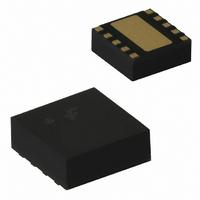RMPA1959 Fairchild Semiconductor, RMPA1959 Datasheet - Page 9

RMPA1959
Manufacturer Part Number
RMPA1959
Description
IC MOD RF POWER AMP 10PIN 4X4LCC
Manufacturer
Fairchild Semiconductor
Type
Power Amplifierr
Datasheet
1.RMPA1959.pdf
(11 pages)
Specifications of RMPA1959
Current - Supply
50mA
Frequency
1.85GHz ~ 1.91GHz
Gain
23dB ~ 25dB
Noise Figure
4dB
Package / Case
11-LCC
Rf Type
CDMA, CDMA2000, PCS
Voltage - Supply
3V ~ 4.2V
Number Of Channels
1
Frequency (max)
1.91GHz
Output Power
28@1880MHzdBm
Power Supply Requirement
Single
Single Supply Voltage (min)
3V
Single Supply Voltage (typ)
3.4V
Single Supply Voltage (max)
4.2V
Package Type
PLCC
Dual Supply Voltage (min)
Not RequiredV
Dual Supply Voltage (typ)
Not RequiredV
Dual Supply Voltage (max)
Not RequiredV
Operating Temperature Classification
Commercial
Operating Temp Range
-30C to 85C
Pin Count
10
Mounting
Surface Mount
Lead Free Status / RoHS Status
Lead free / RoHS Compliant
P1db
-
Test Frequency
-
Lead Free Status / Rohs Status
Compliant
Other names
RMPA1959TR
Available stocks
Company
Part Number
Manufacturer
Quantity
Price
Company:
Part Number:
RMPA1959
Manufacturer:
Fairchild
Quantity:
25
©2004 Fairchild Semiconductor Corporation
Application Information
CAUTION: THIS IS AN ESD SENSITIVE DEVICE
Precautions to Avoid Permanent Device Damage:
• Cleanliness: Observe proper handling procedures to
• Device Cleaning: Standard board cleaning techniques
• Static Sensitivity: Follow ESD precautions to protect
• General Handling: Handle the package on the top with a
• Device Storage: Devices are supplied in heat-sealed,
Device Usage:
Fairchild recommends the following procedures prior to
assembly.
• Dry-bake devices at 125°C for 24 hours minimum. Note:
• Assemble the dry-baked devices within 7 days of
• During the 7-day period, the devices must be stored in an
• If the 7-day period or the environmental conditions have
ensure clean devices and PCBs. Devices should remain
in their original packaging until component placement to
ensure no contamination or damage to RF, DC & ground
contact areas.
should not present device problems provided that the
boards are properly dried to remove solvents or water
residues.
against ESD damage:
– A properly grounded static-dissipative surface on
– Static-dissipative floor or mat.
– A properly grounded conductive wrist strap for each
vacuum collet or along the edges with a sharp pair of
bent tweezers. Avoiding damaging the RF, DC, & ground
contacts on the package bottom. Do not apply excessive
pressure to the top of the lid.
moisture-barrier bags. In this condition, devices are
protected and require no special storage conditions.
Once the sealed bag has been opened, devices should
be stored in a dry nitrogen environment.
The shipping reels cannot withstand 125°C baking
temperature.
removal from the oven.
environment of less than 60% relative humidity and a
maximum temperature of 30°C
been exceeded, then the dry-bake procedure must be
repeated.
which to place devices.
person to wear while handling devices.
Solder Materials & Temperature Profile: Reflow
soldering is the preferred method of SMT attachment. Hand
soldering is not recommended.
• Reflow Profile
Solder Joint Characteristics:
Proper operation of this device depends on a reliable void-
free attachment of the heatsink to the PWB. The solder joint
should be 95% void-free and be a consistent thickness.
Rework Considerations:
Rework of a device attached to a board is limited to reflow
of the solder with a heat gun. The device should not be
subjected to more than 225°C and reflow solder in the
molten state for more than 5 seconds. No more than 2
rework operations should be performed.
– Ramp-up: During this stage the solvents are
– Pre-heat/soak: The soak temperature stage serves
– Reflow Zone: If the temperature is too high, then
– Cooling Zone: Steep thermal gradients may give rise
evaporated from the solder paste. Care should be
taken to prevent rapid oxidation (or paste slump) and
solder bursts caused by violent solvent out-gassing. A
typical heating rate is 1- 2°C/sec.
two purposes; the flux is activated and the board and
devices
recommended soak condition is: 120-150 seconds at
150°C.
devices may be damaged by mechanical stress due to
thermal mismatch or there may be problems due to
excessive solder oxidation. Excessive time at
temperature can enhance the formation of inter-
metallic compounds at the lead/board interface and
may lead to early mechanical failure of the joint.
Reflow must occur prior to the flux being completely
driven off. The duration of peak reflow temperature
should not exceed 10 seconds. Maximum soldering
temperatures should be in the range 215-220°C, with
a maximum limit of 225°C.
to excessive thermal shock. However, rapid cooling
promotes a finer grain structure and a more crack-
resistant solder joint. The illustration below indicates
the recommended soldering profile.
achieve
a
uniform
temperature.
RMPA1959 Rev. D
The












